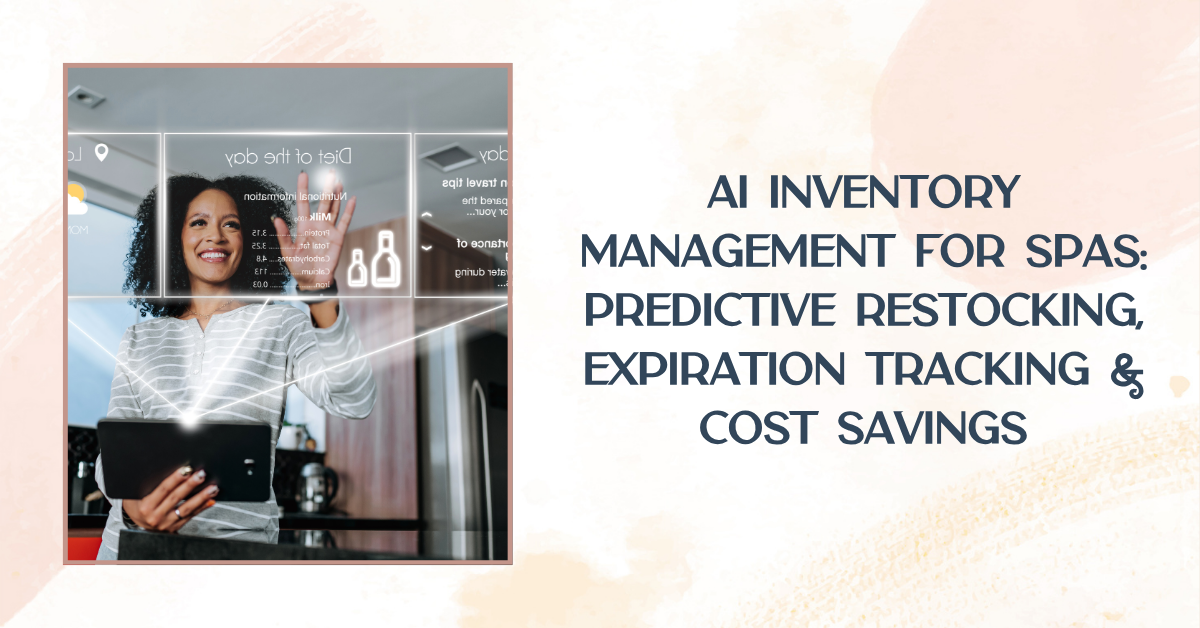Inventory is a hidden leak in many spas. Owners often overorder to score a deal and then end up running last-minute promotions to move product before it expires. That ties up cash that could be used for marketing, payroll, or profit. AI gives you a smarter way to plan and purchase so you have the right items at the right time with less waste and more working capital.
Below is a practical system to modernize your inventory using data you already have. You can do this with the reports in your booking or point of sale software. If your current software does not offer these capabilities, export the right reports and use ChatGPT and Google Sheets to create a lightweight inventory command center.
Inventory has a direct impact on cash flow, guest experience, and treatment quality. With AI doing the pattern spotting, your team can maintain consistency while you make better decisions on budgets and purchasing cycles. When you reduce waste and automate the routine alerts, you win back time and money that can be directed toward growth.

Predictive restocking
AI reads past usage patterns, such as how often a treatment is booked and which back bar items are used per service. From that, it predicts when you will run low and recommends reorder points before you hit panic mode. You can also feed the system monthly usage from the prior year to set seasonal par levels since January demand rarely matches June.
Provider-specific trends
If one provider consistently uses more of a product than others, AI highlights the variance. That may point to a training gap or inconsistency in service delivery. This is most accurate when one provider is assigned to one room and the back bar is signed out as it is restocked.
Expiration and shelf life tracking
AI can track expiration windows and alert you with time to spare. That reduces write-offs and ensures you rotate product before it goes bad. Even without native software features, you can combine Google Sheets and ChatGPT to build an effective expiration log and reminder workflow.

If your booking or point of sale tool lacks robust inventory features, do not wait for an upgrade. Export your service volume and product usage for the last twelve months then build a working system in Google Sheets with help from ChatGPT.
Copy this start prompt into ChatGPT:
“Act as an inventory optimization consultant for a day spa. Based on the following treatments and product usage per service, create a simple AI-assisted inventory tracking system that predicts when I need to restock. Include columns for treatment type, products used quantity, used per treatment, average monthly treatment, volume reorder threshold, current on hand quantity, unit cost supplier, and expiration date. Then show me how to automate alerts using Google Sheets and email. I will paste my service menu and monthly treatment volume next.
Paste your menu and the average number of each service performed per month. Ask ChatGPT to populate the spreadsheet headers and example rows so you can replace the sample data with your own. The goal is a clear working table that your manager can maintain.”
Recommended columns for your master sheet
1. Item name
2. The treatment type that uses this item
3. Quantity used per treatment
4. Average monthly treatment volume
5. Monthly expected usage
6. Reorder threshold
7. Current on-hand quantity
8. Supplier and order minimums
9. Unit cost and extended value on the shelf
10. Lot number and expiration date
11. Notes for storage or rotation

ChatGPT can calculate monthly expected usage from quantity per treatment multiplied by average monthly volume. It can then suggest reorder thresholds and par levels by season once you provide past monthly usage.
How to track provider variance
Create a tab that logs back bar checkouts by room and provider. Ask ChatGPT to create a weekly summary that shows average units per service by provider and flags outliers. If someone uses markedly more cleanser masks or numbing cream, that is your coaching moment. This only works if you assign one provider to one room and require sign-outs for restocking.
How to manage expiration dates
Add conditional formatting so items within sixty days of expiration appear in a bold color. Ask ChatGPT for a Google Sheets script that emails a weekly alert listing any product with an approaching expiration date. Rotate those units into services and promos first to minimize write-offs.
Daily
- The front desk or manager records any incoming orders, received quantities, and lot numbers
- Providers sign out back bar items as they restock rooms
- Low stock items are noted during end of day walk-through
Weekly
- Manager updates on hand quantities and reviews the alert tab for items at or below the reorder threshold
- Review provider usage variance and address coaching opportunities
- Check the expiration tab and plan product rotation in services and scripts for the week
Monthly
- Export service volume reports and paste into your sheet
- Refresh seasonal par levels using last year’s data for the same month
- Place consolidated orders by supplier to meet minimums without overstocking
This cadence keeps your data fresh, which makes the AI suggestions accurate. Most of the work can be done by a trained front desk lead or spa manager while you oversee decisions and budget.

Less waste
Expiration tracking means fewer write-offs and no frantic discounts to move aging items.
Lower emergency shipping
Predictive restocking reduces rush orders and overnight fees.
Right-size purchasing
Seasonal par levels prevent overbuying during slow months and help you scale for peak months. That frees cash that would otherwise sit on the shelf.
Better consistency in service
Provider variance reporting highlights where training can reduce overuse and maintain your treatment standards. Consistent protocols protect margins.
Owners who adopt AI in operations can work faster and often at a lower labor cost, which is a strategic advantage in a competitive market. As CEO, you set the expectation that the business will use AI to improve systems and results.

Step 1: Gather your data
Export the last twelve months of treatment counts and a list of retail and back bar items with current on-hand quantities, unit cost suppliers, and expiration dates where available. If you do not have expiration dates on file, begin collecting them on all future orders.
Step 2: Build your sheet with ChatGPT
Use the prompt above, then paste your service menu and monthly volumes. Ask for formulas that calculate monthly expected usage, reorder points, and suggested order quantities. Keep it simple so the team actually uses it.
Step 3: Create alerts
Ask ChatGPT for step-by-step instructions to set Google Sheets email alerts that send a weekly summary of items below the threshold and items expiring within sixty days. Color-code the rows so your manager can triage quickly.
Step 4: Train your team
Show providers how to sign out the back bar by room and provider. Confirm who owns daily entries, weekly ordering, and monthly report updates. Clarify success metrics such as items below threshold reordered within two business days and zero stockouts in priority categories.
Step 5: Review and optimize
Hold a short weekly meeting to check the numbers and adjust par levels. Celebrate when the system prevents a stockout or catches an expiring lot in time to use it. Small wins build buy-in.
Some booking and point of sale systems already include versions of predictive restocking usage tracking or expiration reminders. Features are being rolled out rapidly. Learn what your platform can already do, then fill the gaps with Google Sheets and ChatGPT until the native features match your needs. The point is to get the benefit now rather than waiting.

- Enter expiration dates for all current lots into your sheet and turn on a sixty-day alert
- Identify your top ten items by monthly usage and set reorder thresholds for each
- Assign one provider to one room and begin back bar sign-outs to enable variance tracking
- Schedule a thirty-minute weekly inventory check so the process never falls behind
Even one of these actions can save real money over a year. Many owners see hundreds or thousands saved from better rotation and smarter purchasing.
Inventory management is not busywork. It is a lever for cash flow quality and client experience. With a simple AI-enabled sheet and a clear weekly cadence, you can stop guessing and start guiding. Your team will know what to do and when to do it. You will know what to buy and when to buy it. And your guests will always receive consistent care with the right products on hand.
Start with one export and one prompt. Build your sheet. Turn on alerts. In a few weeks, you will feel the difference in your bank balance, your back bar, and your stress level. Smart inventory equals consistent service, strong margins, and a calmer owner.

Subscribe to Our Newsletter
Stay up-to-date with our email newsletter to receive important updates, news, and offers!

About the Author
Daniela Woerner is the founder of Addo Aesthetics and creator of the Growth Factor® Framework, a proven system that’s helped hundreds of spa owners build profitable, systemized businesses. With nearly 20 years in the aesthetics industry, she transforms overworked service providers into confident Spa CEOs through strategy, systems, and soul-led support. Daniela is also the host of Spa Marketing Made Easy, a top-ranked podcast with over 1 million downloads, where she shares real-world strategies to help spa professionals grow with clarity and confidence.

